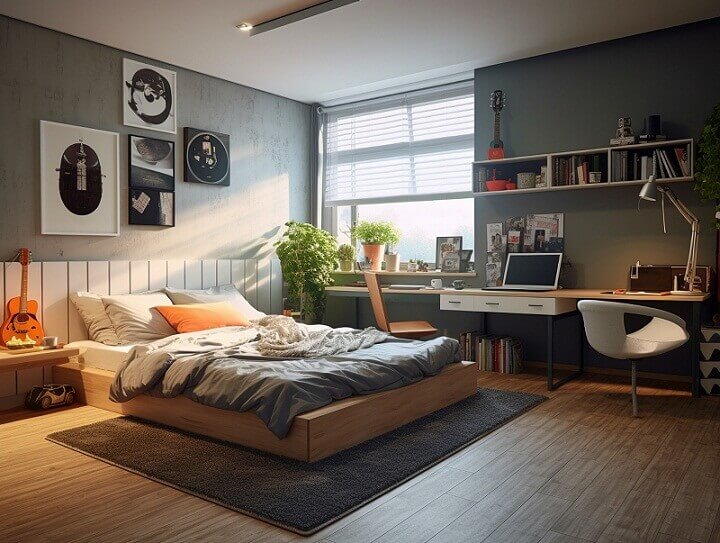
Designing a Stylish and Functional Bedroom: Tips and Tricks
Having a well-designed, functional bedroom that reflects your personal style is incredibly important for improving sleep quality, productivity, and overall well-being. This article will provide practical tips to help you create the ultimate functional bedroom – one that balances aesthetics and functionality to meet your unique needs and preferences. We’ll cover key elements like optimizing layout, selecting the right furniture, enhancing lighting, expressing your style through decor, and incorporating smart storage solutions. Follow along for comprehensive guidance on transforming your bedroom into a personalized sanctuary tailored to you.
Understanding the Basics of Bedroom Design
Defining Functional Bedroom Design
A functional bedroom design focuses on creating a space that is both visually appealing and highly practical in meeting your everyday needs. The key elements that contribute to a functional bedroom include:
- Efficient layout and space utilization – Make the most available space through careful furniture arrangement and multipurpose solutions.
- Comfortable and supportive sleeping environment – Choosing the right bed, mattress, and bedding to enhance comfort and support.
- Ample storage and organization – Incorporating sufficient and accessible storage to keep clutter at bay.
- Lighting and ambiance – Layering lighting sources to create the desired atmosphere and visual appeal.
- Personalization and style – Adding decor, accents, colours, and materials that reflect your aesthetic preferences.
Assessing Your Bedroom Needs
Before redesigning your space, take some time to evaluate how you currently use your bedroom and identify areas for improvement. Consider questions like:
- How do you use your bedroom daily? Is it only for sleeping or do you also relax, work, etc. there?
- What activities do you perform in your bedroom? This will determine the necessary furniture and overall setup.
- What are your storage and organizational needs? Assess how much clothing, accessories, linens, etc. need to be accommodated.
- What is your personal style and design preferences? Take inspiration from spaces that appeal to you.
Optimizing the Bedroom Layout
Careful planning of the overall bedroom layout is crucial for maximizing functionality.
Maximizing Space Utilization
Strategically use every inch of available space for enhanced efficiency:
- Identify and utilize dead or underutilized spaces, like the area under a window.
- Incorporate multifunctional furniture like storage beds and ottomans.
- Mindfully place key elements like the bed, dresser, and nightstands based on room dimensions and traffic flow.
- Use vertical space with shelving, wall storage, lofted beds, and floor-to-ceiling drapes.
Enhancing Traffic Flow
Creating a smooth, unobstructed flow within the bedroom is essential. Follow these tips:
- Position furniture to allow for easy movement between areas.
- Consider the placement of doors, windows, and entryways when orienting furniture.
- Avoid cluttered areas that can obstruct movement around the room.
Incorporating Flexible Zoning
Divide your bedroom into functional zones designated for specific purposes:
- Sleeping area with bed, nightstands, and ambient lighting
- Dressing area with closet, dresser, mirror, and task lighting
- Reading nook or relaxation zone with comfy seating and accent lighting
- Desk or work area for tasks that require focus and motivation
Selecting Functional and Stylish Furniture
Choose pieces that support your daily activities and coordinate with your desired aesthetic.
Choosing the Right Bed
As the central focus, invest in a high-quality bed frame and mattress suited to your needs:
- Select the appropriate size and mattress firmness for your sleeping habits.
- Consider storage beds with built-in drawers to maximize functionality.
- Choose a supportive, durable frame with or without a headboard based on your style preferences.
Optimizing Nightstands and Dressers
Nightstands and dressers provide both visual appeal and key storage solutions:
- Opt for ample surface area to stage decorative items and functional accessories like lamps.
- Look for designs with sufficient drawer and cabinet space to organize clothing, linens, gadgets, etc.
- Coordinate the style with your bed frame and other furnishings to complete the look.
Incorporating Multipurpose Furniture
Versatile, compact pieces allow you to get more function per square foot:
- Storage ottomans provide seating and hidden storage for linens.
- Convertible desks or tables offer a space-saving work surface.
- Wall-mounted shelves or cabinets add vertical storage without taking up floor space.
- Modular cubes or stackable units can be configured to your needs.
Enhancing Lighting and Ambiance
Proper lighting transforms the bedroom into a welcoming retreat.
Layering Lighting Sources
Incorporate a mix of lighting types to create the ideal atmosphere:
- Ambient lighting like flush mounts or semi-flush ceiling fixtures provide overall illumination.
- Task lighting like articulating wall sconces or desk lamps enables focused activities.
- Accent lighting such as string lights or table lamps adds a soft, decorative glow.
Controlling Light and Darkness
Manage natural and artificial light to establish the right ambiance:
- Install curtains, blinds, or blackout shades to control sunlight and darkness.
- Use dimmable bulbs and switches to adjust the brightness of overhead and task lighting.
- Place fixtures strategically to reduce shadows and glare.
Establishing Mood and Atmosphere
Lighting has a significant impact on the overall feel of the space. Consider how factors like color temperature, brightness, and placement can be leveraged to create a relaxing or inviting atmosphere aligned with your personal style.
Incorporating Personal Style and Decor
Decor decisions bring cohesion and infuse your unique personality into the space.
Defining Your Design Style
Consider what inspires you and what you’re naturally drawn to. Common styles include:
- Modern or minimalist
- Traditional or classic
- Rustic or farmhouse
- Bohemian or eclectic
Selecting Complementary Decor
Choose accents that align with your style:
- Textiles like bedding, rugs, and curtains make a statement.
- Wall art, mirrors, and 3D accents reflect your interests.
- Plants, flowers, and natural touches add life.
- Personal mementos and photos add meaning.
Balancing Function and Aesthetics
Seamlessly integrate functional elements into your design:
- Conceal storage behind doors, in closets and drawers.
- Select multifunctional furniture and decor items.
- Use baskets, boxes, and trays to corral clutter.
Optimizing Storage and Organization
Incorporate solutions tailored to your needs that keep your belongings accessible yet out of sight.
Maximizing Closet and Wardrobe Space
Make the most of your primary storage zones:
- Install a closet system with shelves, rods, and drawers.
- Incorporate lighting and mirrors.
- Use vertical space efficiently.
Incorporating Additional Storage Solutions
Supplement beyond the closet with multifunctional furniture and accessories:
- Under-bed drawers are great for extra linens and off-season clothing.
- Wall-mounted cabinets provide display and concealed storage.
- Ottomans, baskets, and boxes stow items while adding decor.
Maintaining a Clutter-Free Environment
Stay organized with these habits:
- Regularly purge unused items and donate.
- Use baskets, trays and bins to neatly contain items.
- Store things conveniently near where they are used.
- Maintain an uncluttered floor space.
Conclusion
Creating a stylish and functional bedroom suited to your needs is achievable by following the tips provided. Start by determining your style, activities, and organizational requirements. Then strategically lay out furniture to optimize space and flow while selecting versatile, coordinated pieces that provide both aesthetics and utility. Layer lighting, incorporate personal touches, and add storage solutions tailored to your belongings. With these steps, you can transform your bedroom into a personalized sanctuary that supports comfort, productivity, and overall well-being.


